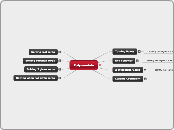Polynomials
Polynomials is an equation containing multiple constants, variables and exponents.
Solving when not given zeros
When solving an equation and there are no given zeros then you must double check your answer and plug it into the calculator. By plugging it into the calculator you may look at the graph or table and see where there are intercepts.
Solving 2 given zeros
When solving for 2 given zeros, factor each equation until there are 2 portions and set each portion to zero and solve when there are 2 zeros.
Solving complex zeros
In solving complex zeros, you can use either the long or synthetic division in solving for zeros within an equation.
Solving real zeros
In solving real zeros you must multiply the equations conjuagte and use long division in order to find the zeros.
Leading Coefficient
The coefficent (number) in front of the the variable of the equation.
X-intercepts/Zeros
The points where the line intercepts with the x-axis.
Identify the degree of a polynomial by zeros
To identify the degree of a polynomial by zeros, you would count the number of times the line intercepts the x-axis. The number of x-intercepts would be the number maxium number of the number of degrees.
If the leading coefficient is positive and even the both end behavior are up if the the leading is positive and odd then one side of the end behavior is up and down. When the leading coefficient is negative and even then the end behavior are both down. If the leading coefficent is odd the end behavior is down.
End Behavior
The part of the graph that where the ends reach an ending point.
Identify the degree of a polynomial by end behavior
To identify the degree of a polynomial by end behaviors. When the polynomial's degree is even the line created was in a shape of a V. Vice versa if the the degree is odd then the shape of the line created is in a S shape.
Identifying multiplicities
To identify the multiplicities it clearly is the exponent in which the polynomial is raised by. And each degree is determines in serveral ways.
Turning Points
The point of the equation where the line increases or decrease creating a change in the line.
Identify the degree of a polynimial by turning points
To identify the amount of turning points you would count the number of turns within the line and total it and then add one.









